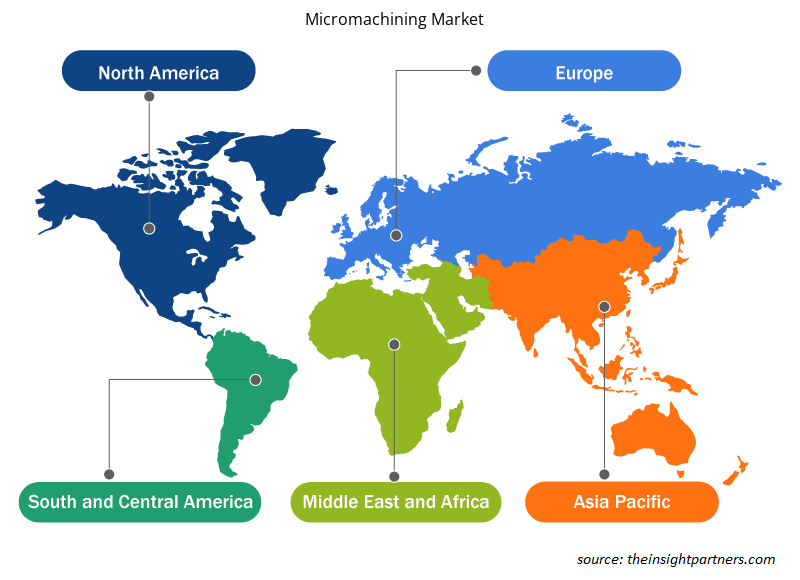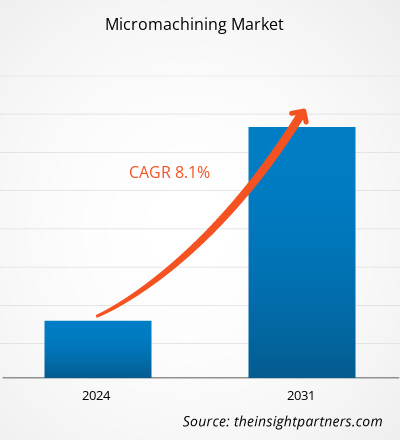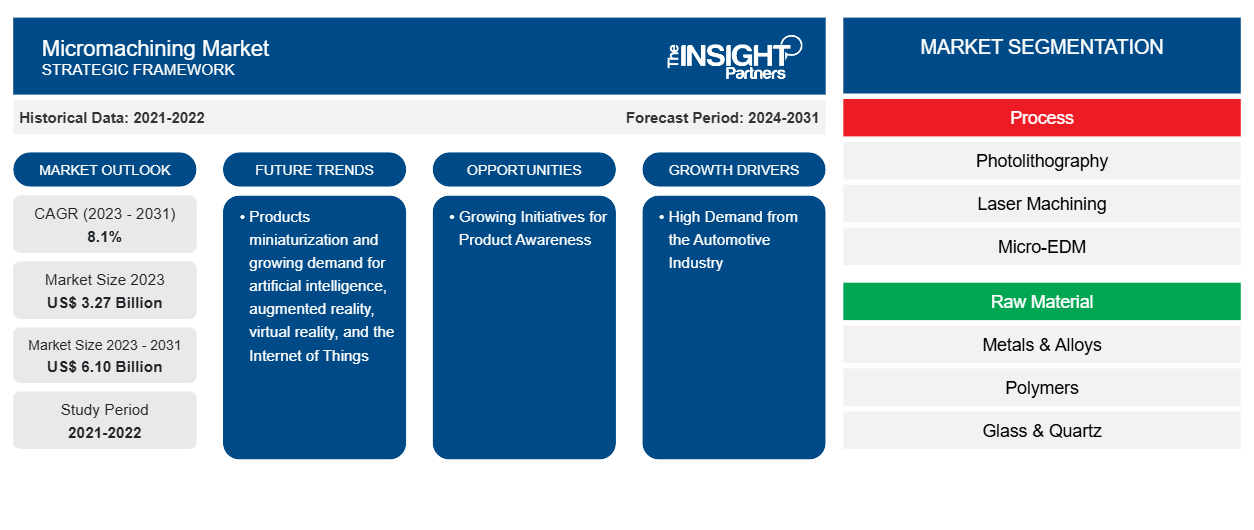微加工市场规模预计将从 2023 年的 32.7 亿美元增至 2031 年的 61 亿美元。预计 2023-2031 年市场复合年增长率将达到 8.1%。产品小型化以及对人工智能、增强现实、虚拟现实和物联网的需求不断增长可能仍是微加工市场的主要趋势。
微加工市场分析
由于汽车行业的高需求以及激光加工和电化学加工的日益普及,微加工市场正在快速增长。受政府为扩大汽车行业而增加的支出以及电动汽车产量的不断增长的推动,市场正在稳步扩大。此外,产品意识的不断提高和传感器融合技术的发展为市场增长提供了有利可图的机会。
微加工市场概况
微加工是在微米级上创建 3D 和 2D 结构的过程。在技术进步之前,手表零件被认为是微小的部件;尽管如此,微型部件后来被用于一系列行业,包括电子和生物医学植入物。随着半导体和电子、汽车、航空航天和医药等行业对紧凑、经济高效和实用产品的需求不断增长,焊接、切割、3D 加工和微铣削等微加工应用也得到了发展。这些行业的改进为市场创造了巨大的增长机会。此外,汽车、消费电子、医疗保健和航空航天行业采用微加工进行微型部件生产也推动了市场的发展。
定制此报告以满足您的需求
您可以免费定制任何报告,包括本报告的部分内容、国家级分析、Excel 数据包,以及为初创企业和大学提供优惠和折扣
-
获取此报告的关键市场趋势。这个免费样品将包括数据分析,从市场趋势到估计和预测。
微加工市场驱动因素和机遇
汽车行业的高需求推动市场发展
由于微加工的广泛应用,它在汽车行业越来越受欢迎。它用于燃油喷射技术,特别是燃油喷射喷嘴。燃油喷射技术可提高车辆行驶里程。燃油喷射喷嘴采用 EDM 工艺进行微加工。汽车行业微加工中激光技术的使用增加了对各种车辆部件进行无缝焊接和粘合的必要性。此外,微加工还可以帮助汽车减少燃料消耗,从而增加消费者对汽车的需求并推动市场发展。
此外,消费者对电动汽车的需求不断增长,这也在预测期内推动了市场的发展。微加工技术广泛应用于光伏电池的制造,极大地扩展了汽车行业。然而,在预测期内,汽车行业的不断扩张和全球消费者对电动汽车的需求不断增长,正在推动市场的发展。
不断增加的产品认知度举措——微加工市场的机会
近年来,提高消费者认知的活动越来越多,各国政府也计划举办以微加工为基础的活动或会议,以提高用户的认知度。例如,国际研究会议计划于 2024 年 6 月 27 日至 28 日在土耳其伊斯坦布尔举办国际微加工会议 (ICM)。此次会议涵盖了微加工的各个方面,包括最新的突破、趋势和关注点,以及微加工领域面临的实际问题和实施的解决方案,这在不久的将来加速了市场的增长。
微机械加工市场报告细分分析
有助于得出微机械市场分析的关键部分是工艺、原材料和应用。
- 根据工艺,微加工市场分为光刻、激光加工、微电火花加工和微机械加工。激光加工细分市场分为 CO2 激光微加工、红外激光微加工、绿色激光微加工和紫外激光微加工。光刻细分市场在 2023 年占据了更大的市场份额。
- 根据原材料,市场分为金属和合金、聚合物、玻璃和石英以及陶瓷。聚合物部分在 2023 年占据了更大的市场份额。
- 从应用方面来看,微加工市场分为航空航天和国防、医疗、电信、半导体和电子、汽车、工业等。2023 年,汽车领域占据了更大的市场份额。
微机械加工市场份额按地区分析
微机械市场报告的地理范围主要分为五个区域:北美、亚太、欧洲、中东和非洲、南美/南美和中美。
就收入而言,亚太市场占据了最大的微加工市场份额,因为中国、印度和韩国等国家/地区拥有主要的汽车零部件制造商。这些制造商对微加工的需求很高,用于制造燃油喷射器、电气组件和汽车传感器等主要汽车零部件。此外,人们对微加工带来的好处的认识不断提高,铁路和能源行业的需求不断增长,也推动了市场的发展。
微加工市场区域洞察
Insight Partners 的分析师已详细解释了预测期内影响微加工市场的区域趋势和因素。本节还讨论了北美、欧洲、亚太地区、中东和非洲以及南美和中美洲的微加工市场细分和地理位置。

- 获取微机械加工市场的区域特定数据
微加工市场报告范围
| 报告属性 | 细节 |
|---|---|
| 2023 年的市场规模 | 32.7亿美元 |
| 2031 年市场规模 | 61亿美元 |
| 全球复合年增长率(2023 - 2031) | 8.1% |
| 史料 | 2021-2022 |
| 预测期 | 2024-2031 |
| 涵盖的领域 |
按工艺
|
| 覆盖地区和国家 |
北美
|
| 市场领导者和主要公司简介 |
|
微机械加工市场参与者密度:了解其对业务动态的影响
微加工市场正在快速增长,这得益于终端用户需求的不断增长,而这些需求又源于消费者偏好的不断变化、技术进步以及对产品优势的认识不断提高等因素。随着需求的增加,企业正在扩大其产品范围,进行创新以满足消费者的需求,并利用新兴趋势,从而进一步推动市场增长。
市场参与者密度是指在特定市场或行业内运营的企业或公司的分布情况。它表明相对于给定市场空间的规模或总市场价值,有多少竞争对手(市场参与者)存在于该市场空间中。
在微机械加工市场运营的主要公司有:
- 3D-Micromac 公司
- 4JET Microtech GmbH
- IPG Photonics 公司
- KJ 激光微加工
- OpTek 有限公司
- 牛津激光有限公司
免责声明:上面列出的公司没有按照任何特定顺序排列。

- 获取微机械加工市场顶级关键参与者的概述
微加工市场新闻和最新发展
微加工市场通过收集一手和二手研究后的定性和定量数据进行评估,其中包括重要的公司出版物、协会数据和数据库。以下是微加工市场的发展和战略列表:
- 2023 年 8 月,Posalux 集团在 SEMICON Europa 2023 上推出了两款机器:ULTRASPEED MONO 和 ULTIMATE DUO。该活动与 Productronica 同期举办,计划于 11 月 14 日至 17 日在德国慕尼黑举行,对于那些对机械微加工技术前沿感兴趣的人来说,这将是一个重要时刻。(来源:Posalux 集团,新闻稿,2023 年)
微机械加工市场报告范围和交付成果
“微机械加工市场规模和预测(2021-2031)”报告对以下领域进行了详细的市场分析:
- 范围内所有主要细分市场的全球、区域和国家层面的市场规模和预测
- 市场动态,如驱动因素、限制因素和关键机遇
- 未来的主要趋势
- 详细的 PEST/波特五力分析和 SWOT 分析
- 全球和区域市场分析涵盖关键市场趋势、主要参与者、法规和最新市场发展
- 行业格局和竞争分析,涵盖市场集中度、热点图分析、知名参与者和最新发展
- 详细的公司简介
- 历史分析(2 年)、基准年、预测(7 年)及复合年增长率
- PEST和SWOT分析
- 市场规模、价值/数量 - 全球、区域、国家
- 行业和竞争格局
- Excel 数据集
近期报告
客户评价
购买理由
- 明智的决策
- 了解市场动态
- 竞争分析
- 客户洞察
- 市场预测
- 风险规避
- 战略规划
- 投资论证
- 识别新兴市场
- 优化营销策略
- 提升运营效率
- 顺应监管趋势























 获取免费样品 - 微加工市场
获取免费样品 - 微加工市场